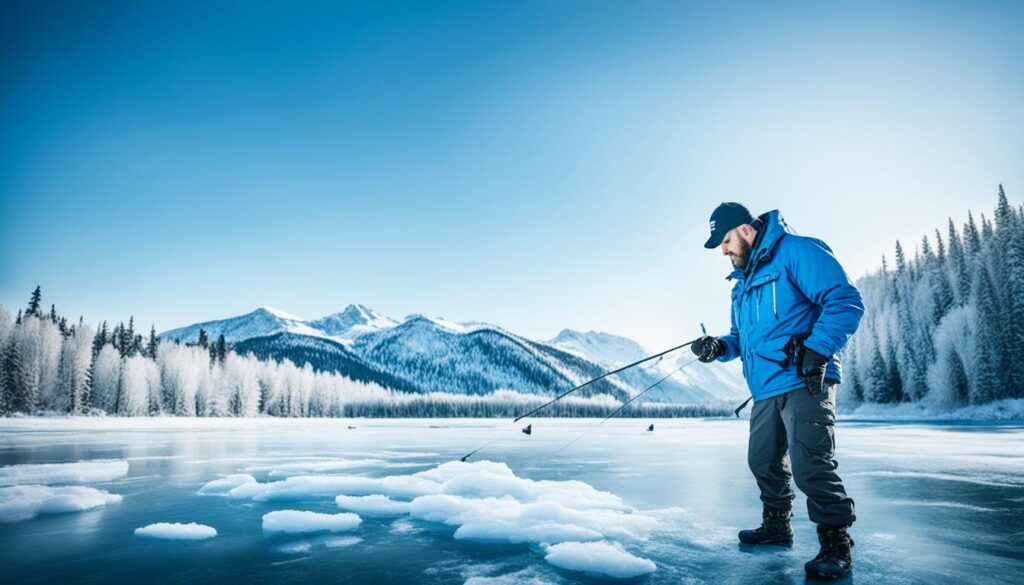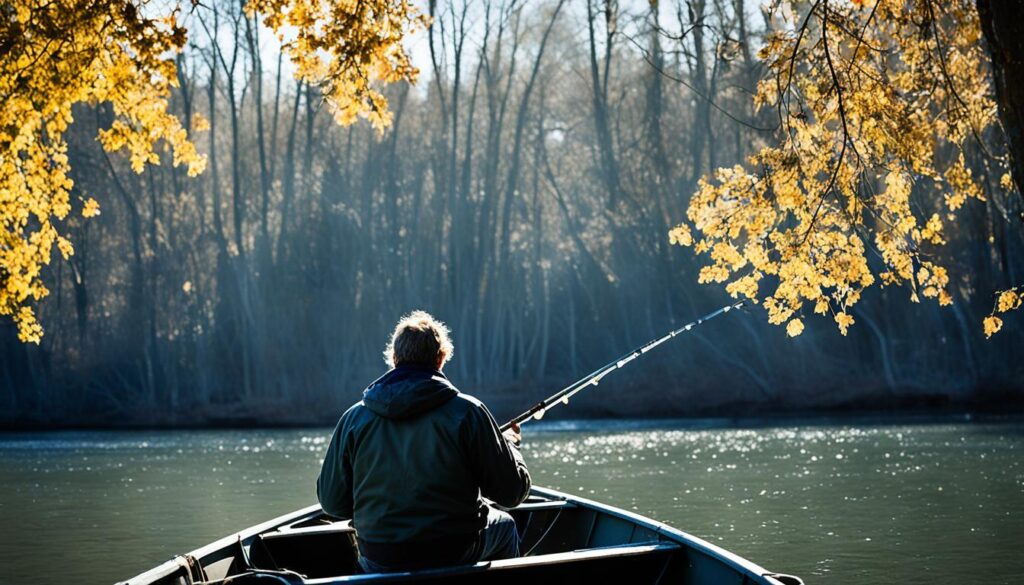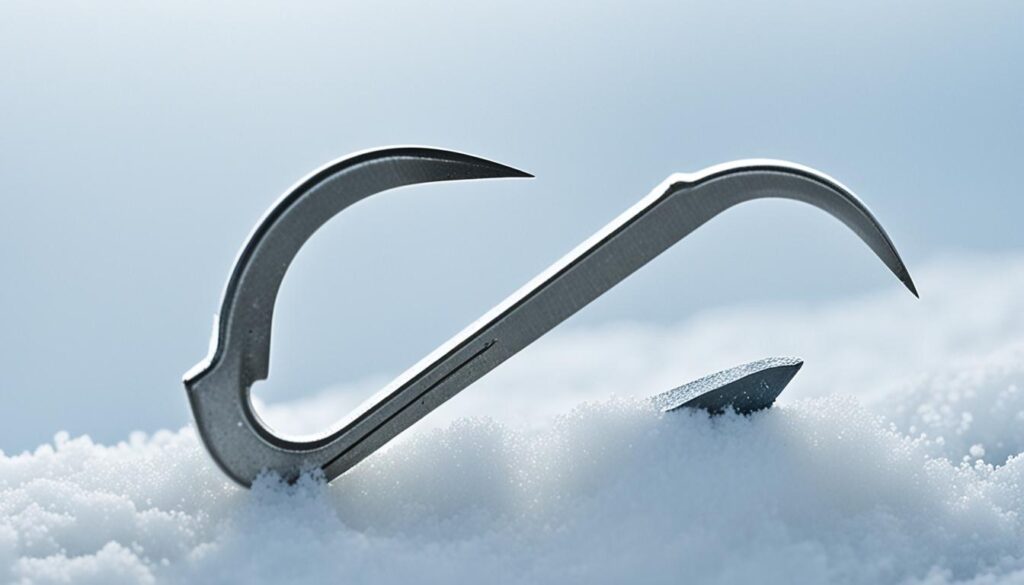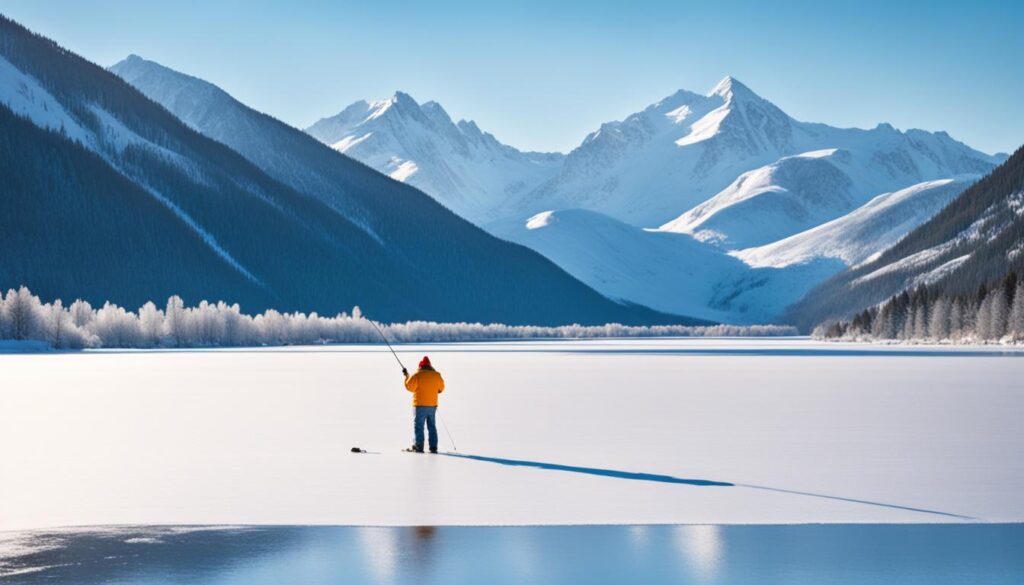Winter bass fishing can be a challenging yet rewarding experience for anglers. As the seasons change and water temperatures drop, bass become less active, making them trickier to catch. To increase your chances of success, it’s crucial to avoid common bass fishing mistakes that many anglers make during the colder months. In this article, we’ll explore the best winter bass fishing techniques, highlight the common pitfalls to steer clear of, and provide valuable tips and strategies to help you land more bass, even in frigid conditions.
By addressing and avoiding these common bass fishing mistakes, you’ll be better equipped to outsmart the bass and enjoy a productive day on the water, despite the winter chill.
Key Takeaways:
- Avoid These Winter Bass Fishing Mistakes for Consistency
- Implement the best winter bass fishing techniques
- Learn how to catch bass in winter
- Improve your winter bass fishing performance
- Follow tips and strategies for successful winter bass fishing
Retrieving too fast
One common mistake anglers make in winter bass fishing is retrieving too fast. In cold water, bass are more lethargic and have slower reaction times. It’s important to slow down your retrieve and move with purpose. Resist the temptation to rush your movements and maintain a slow and steady retrieve to entice bites from sluggish bass.
When retrieving too fast, your presentation may appear unnatural and can quickly go unnoticed by bass. To trigger their feeding response, the key to success in winter bass fishing is to mimic the slow movements of the bass’s natural prey, such as baitfish and crawfish.
By slowing down your retrieve and using a steady, deliberate motion, you give the bass enough time to examine and strike your bait. This technique allows the bass to track and assess your presentation, increasing the chances of a successful hookup.
A slow and steady retrieve also enables your lure to stay in the strike zone longer, ensuring that it remains visible and enticing to the bass. This method is especially effective when using lures that imitate injured or dying baitfish, as their sluggish movements trigger a predatory response from bass.
“When fishing in winter, I always make sure to retrieve my bait at a slower pace. The bass are less active, so I need to entice them to strike by presenting my lure in a way that is easy for them to catch. A slow and steady retrieve has consistently produced great results for me.” – Mark Anderson, experienced angler
Please remember that winter bass fishing requires patience and precision. Adjusting your retrieve speed and taking a slow and steady approach can increase your chances of attracting bites from winter bass. So, next time you hit the water during the colder months, resist the urge to retrieve too fast and let the bass come to you.
Not casting enough
When it comes to winter bass fishing, one mistake that anglers often make is not casting enough. In cold water, bass tend to be more sluggish and react slower. Adjusting your casting techniques accordingly can increase your chances of success.
Instead of continuously moving from one spot to another, consider over-saturating a single area before moving on. This means making multiple casts to cover the targeted zone thoroughly. Give the bass ample time to detect and reach your bait. Patience is vital in winter bass fishing, as it may take longer for the fish to notice and react to your lure.
By over-saturating your casting in cold water, you increase the likelihood of attracting bass that are nearby but may not have noticed your initial casts. Remember, these fish have slower reaction times, so providing them with repeated opportunities to strike can lead to more hook-ups.
To illustrate this point visually:
| Bass Fishing Approach | Result |
|---|---|
| Not casting enough | Limited bites and missed opportunities due to fish not detecting the bait. |
| Over-saturating casting in a single area | Increased chances of attracting bass that may not have reacted initially, leading to more bites and successful hook-ups. |
Remember, adjusting your casting techniques in winter bass fishing is crucial. Feel free to spend more time in one area, thoroughly covering it with your casts. Giving the bass ample time to detect and react to your bait can make all the difference in landing more fish.

Plopping
In winter bass fishing, plopping is a technique that can make or break your chances of success. The sound of a lure breaking the water’s surface can startle bass, causing them to retreat. With clearer waters and fewer distractions in the winter months, bass have a clearer line of sight to your presentation, so it’s crucial to master delicate casting to avoid loud splashes and ensure a more natural and enticing bait presentation.
Delicate casting involves making accurate and gentle casts, minimizing the disturbance on the water’s surface. By paying attention to how your bait breaks the surface, you can create a more subtle entry that mimics the natural movements of prey. This winter bass fishing technique can significantly increase your chances of enticing bass to strike.
Remember, the key is to be patient and make precise casts, so your bait lands softly and creates minimal commotion. This allows the bass to focus on your offering without being spooked by a loud plop. Practicing this technique will help you maximize your catches during the winter season.
Staying in the shade
When it comes to winter bass fishing, paying attention to your fishing environment can make a big difference in your success. One important factor to consider is the movement of the sun. Bass are known to be more active in areas that receive direct sunlight, especially during the colder months. By staying in the shade and fishing in sunny areas, you can increase your chances of hooking a winter bass.
Start your fishing journey in areas where the sunlight is shining brightly. As you observe the sun’s movement, adjust your position accordingly to stay in the shade while keeping your bait in the sunlight. This technique allows you to maximize your chances of attracting the attention of active bass while avoiding unproductive waters.
Fishing in sunny areas has its advantages. With the sunlight warming up the water, bass tend to be more active and responsive to lures. The increased visibility also allows you to better spot bass movements and target them more effectively. By adjusting yourself to where the sunlight is shining, you are essentially positioning yourself in the bass’s line of sight, increasing your chances of a successful catch.
It’s important to note that as the sun moves throughout the day, the shade will change. Be aware of the changing angle and adjust your position accordingly to ensure you stay in the shade, optimizing your chances of success.
| Benefits of Staying in the Shade | Key Points |
|---|---|
| Increased bass activity | • Bass are more active in areas receiving direct sunlight • Sunlight warms up the water and stimulates bass feeding behavior |
| Improved visibility | • Clearer waters in sunny areas allow for better visibility • Easier spotting of bass movements |
| Enhanced lure effectiveness | • Adjusting to where the sunlight is shining positions the lure in bass’s line of sight • Increases the chances of attracting bass to your presentation |
By staying in the shade and strategically positioning yourself in sunny areas, you can take advantage of bass behavior during winter fishing. Pay attention to the sun’s movement, adjust accordingly, and make the most of the opportunities presented by the changing light conditions. Remember, fishing in the shade can bring you closer to successful winter bass catches.

Dull Hooks
When it comes to winter bass fishing, having sharp hooks is essential for increasing your chances of hooking bass successfully. In colder waters, bass develop thicker skin on their mouths, making it harder for dull hooks to penetrate. To maintain a high hook-up ratio, it’s important to keep your hooks sharp and ready for action.
To sharpen your hooks, take the time to inspect each one before your fishing trips. Look for any signs of dullness or corrosion and use a hook sharpening tool to restore their sharpness. Pay particular attention to the points, ensuring they are razor-sharp and can easily penetrate a bass’s mouth.
When fishing in rocky structures, it’s even more crucial to sharpen your hooks. The rocks can quickly dull your hooks, making them less effective in hooking fish. Sharpening your hooks before each cast will ensure efficient penetration and increase your chances of landing that prized winter bass.

Benefits of Sharpening Hooks in Winter
| Benefits | Explanation |
|---|---|
| Improved hook-up ratio | Sharp hooks can penetrate bass’s mouths more effectively, leading to a higher hook-up ratio. |
| Increased fish retention | Sharp hooks reduce the chances of fish shaking off during the fight, increasing your chances of landing them. |
| Enhanced sensitivity | Sharp hooks allow for better detection of subtle bites, allowing you to respond quickly and increase your catch rate. |
| Improved overall fishing performance | By maintaining sharp hooks, you’ll be prepared for any fishing situation, giving you confidence and improving your overall performance on the water. |
Don’t let dull hooks be the reason why you miss out on hooking winter bass. Regularly sharpen your hooks, especially before venturing into rocky areas, and reap the benefits of improved hook-up ratios, increased fish retention, enhanced sensitivity, and overall fishing success.
Doubting Your Baits and Lures
In winter, when bites are less frequent, it’s easy to doubt your baits and lures. However, it’s important to have confidence in your tackle and not change lures too frequently. Stick with your winter confidence baits and colors, such as muted tones for a natural presentation.
Trusting in your previous success and relying on proven baits can help attract bites from elusive winter bass. By sticking with what has worked for you in the past, you can maintain your confidence and increase your chances of success.
“I’ve learned that doubting my baits and lures only leads to unnecessary frustration. By having confidence in my tackle, I’ve been able to consistently catch bass in wintertime. Trust your instincts and stick with what has worked for you in the past.”
Tried and True Baits for Winter Bass Fishing
When selecting baits for winter bass fishing, it’s essential to choose those that have consistently proven effective. Here are some popular confidence baits for winter:
| Bait Type | Recommended Brands |
|---|---|
| Jerkbaits | Lucky Craft Pointer, Megabass Vision 110, Rapala X-Rap |
| Soft Plastic Worms | Zoom Trick Worm, Yum Dinger, Roboworm Straight Tail Worm |
| Bladed Jigs | Jackall Dowzswimmer, Z-Man ChatterBait, Strike King Thunder Cricket |
These baits have proven track records of attracting bites from winter bass. Their lifelike appearances, subtle actions, and natural presentations make them highly effective in cold water conditions.
Remember, gaining confidence in your baits and lures takes time and experience. By sticking with your proven choices and being patient, you’ll increase your chances of landing that elusive winter bass.
Neglecting The Line
The type of line and diameter you use significantly impact your winter bass fishing performance. Choosing the right line can increase sensitivity and help your crankbaits sink to the desired depth. In winter fishing conditions, where bass are often more profound and less active, paying attention to your line selection is crucial for optimal results.
One recommended line option for winter bass fishing is the fluorocarbon line. Fluorocarbon lines have excellent sensitivity, allowing you to feel even the subtlest bites. Additionally, they have a higher density than monofilament lines, which helps your bait sink faster and reach the desired depth quickly.
When selecting your line, please take into account the fishing conditions and adjust accordingly. You can use a lighter line diameter in clear waters with light fishing pressure for increased sensitivity. If fishing in heavy cover or rocky areas, consider a more robust line to handle potential snags and abrasions. You can just experiment with different line options to find the one that works best for you.
| Line Type | Advantages | Disadvantages |
|---|---|---|
| Berkley Trilene 100% Fluorocarbon | Excellent sensitivity Low visibility in water Quick sinking | More expensive than other options Less forgiving on knots |
| Celsius Cold Weather Monofilament | Great versatility Absorbs shock well Economical | Higher visibility in water Less sensitive |
| Reaction Tackle Braided Fishing Line | High strength Minimal stretch Durable | High visibility in water May require a leader for finesse presentations |
Common bass fishing mistakes
To improve your winter bass fishing skills, it’s important to continuously learn and adapt. Keeping a fishing journal is one of the most effective ways to enhance your understanding of the patterns and trends in your fishing area. By recording details such as locations, dates, times, lures, and baits used, you can identify successful techniques and replicate them in similar conditions. A fishing journal acts as a valuable reference that allows you to track your progress and make informed decisions on future trips.
However, it’s crucial not to rely solely on past notes or history. The conditions in winter bass fishing can vary, and what worked before may not be as effective in the current conditions. Observing and adapting to the present circumstances is key to optimizing your results. By staying up to date with the latest techniques, researching new strategies, and learning from experienced anglers, you can refine your skills and stay ahead of the game.
Keep in mind that winter bass fishing requires flexibility and openness to experimentation. Each outing presents a unique set of conditions, including water temperature, weather patterns, and bass behavior. By continuously learning and adapting, you can respond effectively to these factors and increase your chances of success.
Is It Fruitful to Fish in Cold Weather?
Contrary to popular belief, fishing in cold weather can be fruitful. While fish may slow down and change their behavior to survive harsh winter conditions, they still need to eat. Understanding this can open up opportunities for successful winter fishing. Learning new tactics and branching out into cold-weather fishing can be rewarding and provide a unique experience.
“The only thing standing between you and catching fish in cold weather is the misconception that it’s not possible.”
– Expert angler, Sarah Johnson
Many anglers avoid fishing in cold weather due to certain misconceptions. However, with the right knowledge and techniques, winter fishing can be extremely productive. Here are some benefits of winter fishing:
- Less competition: Many anglers prefer to stay indoors during the winter months, leading to less fishing pressure and more opportunities for successful catches.
- Quality fish: Cold water temperatures often result in larger and healthier fish. They tend to group up in specific areas, making them more predictable and easier to target.
- New challenges: Winter fishing requires anglers to adapt their strategies and techniques. It provides an opportunity to learn and improve your skills, making you a more versatile angler overall.
- Beautiful surroundings: Fishing in the cold weather offers stunning winter landscapes and peaceful surroundings. It’s a chance to appreciate nature in a different season.
So, don’t let the cold weather discourage you from pursuing your angling passion. Embrace the challenge, equip yourself with the right knowledge and gear, and explore the rewards of winter fishing.
Strategies to Catch Bass in Cold Weather
To increase your success in catching bass during the winter season, it is essential to implement strategic techniques that take into account the unique characteristics of cold weather fishing. By following these strategies, you can optimize your chances of landing that elusive winter bass.
1. Slow Down Your Presentation
During winter, bass have a slower metabolism and are less aggressive in their feeding behavior. To entice bites, it is crucial to slow down your presentation. Use a more methodical and deliberate approach, allowing your bait to stay in the strike zone for a longer period. This will give the sluggish bass ample time to notice and strike your lure.
2. Avoid Windy Spots
Windy spots can create choppy water conditions, making it difficult for bass to detect your presentation. Bass tend to seek out calmer areas with reduced current during the winter months. Focus on targeting areas shielded from the wind, such as coves, pockets, or areas protected by structure or landmasses. This will increase your chances of finding actively feeding bass.
3. Consider Water Clarity and Lure Color
Water clarity plays a crucial role in winter bass fishing. In clearer water, bass have better visibility and can scrutinize your bait more closely. Select lures that match the natural coloration of the forage in the waterbody. Muted, natural colors are generally effective during winter. Experiment with different lure colors and adjust based on the water clarity to increase your chances of enticing strikes.
4. Use the Right Lures
In cold weather, certain lure types excel in enticing bites from lethargic bass. Jerkbaits, spoons, and jigs are popular choices during winter. Jerkbaits mimic injured baitfish and can be worked slowly to trigger strikes. Spoons are effective at imitating dying or injured baitfish and can be vertically jigged to entice bass. Jigs, especially those with subtle action, can be crawled along the bottom to imitate easy prey for bass.
5. Go for Bigger Fish
Winter is a great time to target larger, trophy-sized bass. During this season, bigger fish feed less frequently but opt for larger meals to sustain themselves. By focusing on targeting bigger fish, you increase your chances of landing a true trophy bass. Use larger lures to lure those big bass out from their hiding spots and entice them with a substantial meal.
6. Wear Appropriate Gear
When venturing out for winter bass fishing, it’s crucial to wear appropriate cold-weather gear. Layer your clothing to ensure warmth and insulation against the elements. Opt for waterproof and windproof outerwear to protect yourself from harsh conditions. Keep your hands warm with gloves designed for fishing, and don’t forget to wear a hat and appropriate footwear to stay comfortable during your fishing trip.
7. Yo-Yo Your Lure
Using a yo-yo retrieval pattern can be effective in enticing strikes from bass during winter. After casting your lure, allow it to sink to the desired depth, then raise it quickly. Pause momentarily and let it sink again before repeating the process. This erratic movement can mimic a dying baitfish and trigger a predatory response from bass.
8. Monitor Feeding Windows
During winter, bass have specific feeding windows when they are most active. This can be influenced by factors such as water temperature, sunlight, and moon phase. Pay attention to these variables and adjust your fishing schedule accordingly. Early mornings and late afternoons are usually productive periods for winter bass fishing. By aligning your fishing time with these feeding windows, you increase your chances of encountering active and feeding bass.
Conclusion
In summary, winter bass fishing can be a challenging endeavor, but with the right approach, you can achieve consistent success. By avoiding common mistakes and implementing effective strategies, you can increase your chances of a fruitful outing. Remember to slow down your presentation, as bass in cold water have slower reaction times. Choose the right lures and colors that mimic natural baitfish to entice bites from lethargic bass. It’s crucial to adapt to the current conditions and be patient and observant throughout your fishing experience.
Furthermore, don’t underestimate the power of learning from each fishing trip. Keep a fishing journal to record important details such as locations, dates, times, and bait used. This information will help you identify patterns and trends in your fishing area, improving your overall performance. However, always fish according to the current conditions and be open to adapting your strategies for optimal success.
By avoiding winter bass fishing mistakes, you set yourself up for consistent success. Be mindful of common errors such as retrieving too fast, not casting enough, making loud splashes, staying in the shade, neglecting dull hooks, doubting your baits and lures, and not paying attention to the line. Each of these mistakes can impact your chances of hooking bass in winter. Remember, winter bass fishing requires a different approach than other seasons, so adjust your techniques accordingly. With patience, perseverance, and the right strategies, you can improve your winter bass fishing performance and enjoy fruitful outings even in the coldest months.
FAQ
What is one common mistake to avoid in winter bass fishing?
One common mistake to avoid in winter bass fishing is retrieving too fast. In cold water, bass are more lethargic and have slower reaction times. It’s important to slow down your retrieve and maintain a slow and steady pace.
Are there any tips for casting in winter bass fishing?
Yes, when casting in winter bass fishing, it’s important to not cast enough. Bass in cold water have slower reaction times, so it’s recommended to over-saturate a single area before moving on. Be patient and give the bass ample time to reach the target area.
How can I avoid spooking bass in winter?
To avoid spooking bass in winter, practice delicate casting and make accurate, gentle casts to avoid the loud splashes that can startle fish. Pay attention to how your bait breaks the surface to ensure a more natural presentation.
Should I target sunny areas in winter bass fishing?
Yes, bass in cold water are more likely to be active in areas receiving sunlight. Start fishing in sunny areas and pay attention to how the sun’s position changes. Adjust yourself to where the sunlight is shining to increase your chances of success.
Why is it important to keep hooks sharp in winter bass fishing?
Dull hooks can decrease your chances of successfully hooking bass in winter. With thicker skin on their mouths, it’s important to keep your hooks sharp. Take the time to sharpen your hooks, especially when fishing in rocky structures.
Should I stick with the same baits and lures in winter bass fishing?
Yes, in winter bass fishing it’s important to have confidence in your tackle and not change lures too frequently. Stick with your winter confidence baits and colors, such as muted colors for a natural presentation. Trust in your previous success and rely on proven baits.
What type of line should I use in winter bass fishing?
The type of line and diameter you use have a significant impact on your winter bass fishing performance. Choose a line that increases sensitivity and helps your crankbaits sink to the desired depth. Fluorocarbon lines are recommended for their sensitivity and sinking ability.
How can I improve my winter bass fishing skills?
To improve your winter bass fishing skills, it’s important to continuously learn and adapt. Keep a fishing journal to record details such as locations, dates, times, lures, and baits used. This information will help you understand patterns and trends in your fishing area.
Is fishing in cold weather fruitful?
Contrary to popular belief, fishing in cold weather can be fruitful. While fish may slow down and change their behavior to survive harsh winter conditions, they still need to eat. Understanding this can open up opportunities for successful winter fishing.
What strategies can I use to catch bass in cold weather?
To catch bass in cold weather, implement strategic techniques. Slow down your presentation, avoid windy spots, target sunny areas, pay attention to water clarity and choose lure colors that mimic baitfish, use the right lures, go for bigger fish, wear appropriate cold-weather gear, utilize a yo-yo retrieval pattern, and be aware of feeding windows.
